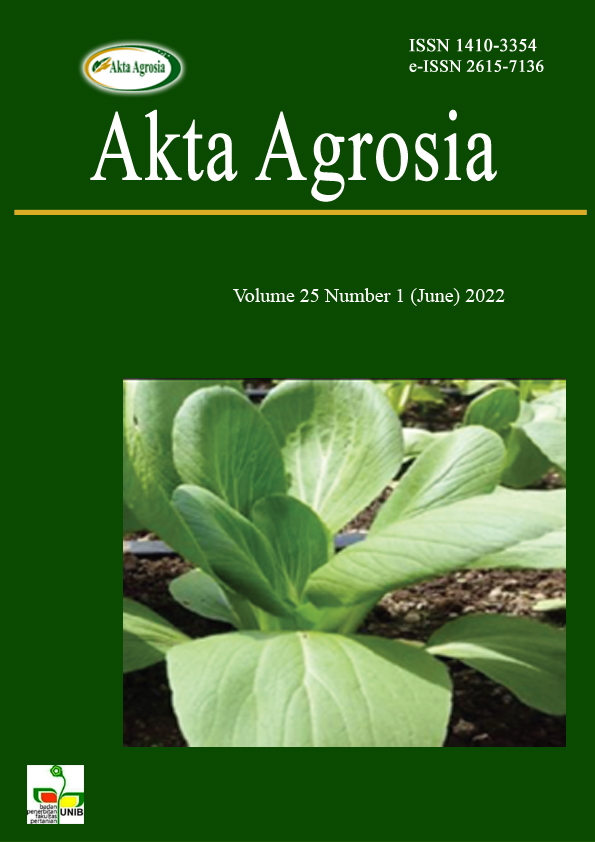Main Article Content
Abstract
The reserach aims to determine the potential of antagonistic rhizobacteria and is appropriate formulations used to control sheat root disease (Sarocladium oryzae). This research was carried out in July to December 2019 in the Plant and Disease Laboratory and the Greean House Faculty of Agriculture Jember University. The experiment was conducted using a completely slot deposit 5000 randomized design (CRD) 2 factors, namely isolates and formulation. Isolates factors have 4 factors levels; control, Bacillus sp. isolate, Pseudomonas fluorescens isolate, and Bacillus sp. + Pseudomonas fluorescens isolate. The formulation factors has 4 factors levels; glucose 10% + potato water 70% + bacterial starter 20%, Fructose 20% + coconut water 60% + bacteria; starter 20%, glucose 10% + CMC 2% + monmorilonite 68% + bacterial starter 20%, fructose 20% + CMC 2% + kaolin 58% + bacterial starter 20%. The result showed that the treatment of Bacillus sp. with formulation glucose 10% + CMC 2% + monmorilonite 68% + bacterial starter 20%, showed the best result, with a control effectiveness of 78.31%.
Key word; Formulation, Rhizobacteria antagonist, Sarocladium oryzae
Article Details
Copyright (c) 2022 Abdul Majid, Keke Yunadia Kumala Dewi

This work is licensed under a Creative Commons Attribution-ShareAlike 4.0 International License.
Authors who publish with this journal agree to the following terms:
- Authors retain copyright and grant the journal right of first publication with the work simultaneously licensed under a Creative Commons Attribution License that allows others to share the work with an acknowledgement of the work's authorship and initial publication in this journal.
- Authors are able to enter into separate, additional contractual arrangements for the non-exclusive distribution of the journal's published version of the work (e.g., post it to an institutional repository or publish it in a book), with an acknowledgement of its initial publication in this journal.
- Authors are permitted and encouraged to post their work online (e.g. in institutional repositories or on their website) prior to and during the submission process, as it can lead to productive exchanges, as well as earlier and greater citation of published work (See The Effect of Open Access).
References
- REFERENCES
- Badan pusat statistik. 2017. Statistik Pertanian. Jakarta, Indonesia.
- Du, P., L. Loam, N. Cuong, H. Nghiep, dan N. Danh. 2001. Survey on Seed Borne Fungi and its Effects on Grain Quality of Common Rice Cultivars in the Mekong Delta. Omonrice, 9(1): 107-113.
- Jatnika, W., A. L. Abadi, dan L. Q. Aini. 2013. Pengaruh Aplikasi Bacillus sp. dan Pseudomonas sp. terhadap Perkembangan Penyakit Bulai yang disebabkan oleh Jamur Patogen Peronosclerospora maydis pada Tanaman Jagung. HPT, 1(4): 19-29.
- Sakhtivel, N. 2001. Sheat Rot Disease of Rice: Current Status and Control Strategies. Kluwer Aademic, 1(1): 271-283.
- Soesanto, L., E. Mugiastuti, dan R. F. Rahayuniati. 2011. Morphological and Physiological Features of Pseudomonas fluorescens P60. Researchgate, 1(1): 1-9.
- Suriani, N. Djaenuddin, dan A. Muis. 2018. Efikasi Formulasi Bacillus subtilis terhadap Pengendalian Penyakit Busuk Batang Fusarium pada Tanaman Jagung. Tanaman Pangan. 2(3): 191-197.
- Suwahyono, U. 2013. Membuat Biopestisida. Jakarta: Penebar Swadaya
References
REFERENCES
Badan pusat statistik. 2017. Statistik Pertanian. Jakarta, Indonesia.
Du, P., L. Loam, N. Cuong, H. Nghiep, dan N. Danh. 2001. Survey on Seed Borne Fungi and its Effects on Grain Quality of Common Rice Cultivars in the Mekong Delta. Omonrice, 9(1): 107-113.
Jatnika, W., A. L. Abadi, dan L. Q. Aini. 2013. Pengaruh Aplikasi Bacillus sp. dan Pseudomonas sp. terhadap Perkembangan Penyakit Bulai yang disebabkan oleh Jamur Patogen Peronosclerospora maydis pada Tanaman Jagung. HPT, 1(4): 19-29.
Sakhtivel, N. 2001. Sheat Rot Disease of Rice: Current Status and Control Strategies. Kluwer Aademic, 1(1): 271-283.
Soesanto, L., E. Mugiastuti, dan R. F. Rahayuniati. 2011. Morphological and Physiological Features of Pseudomonas fluorescens P60. Researchgate, 1(1): 1-9.
Suriani, N. Djaenuddin, dan A. Muis. 2018. Efikasi Formulasi Bacillus subtilis terhadap Pengendalian Penyakit Busuk Batang Fusarium pada Tanaman Jagung. Tanaman Pangan. 2(3): 191-197.
Suwahyono, U. 2013. Membuat Biopestisida. Jakarta: Penebar Swadaya
